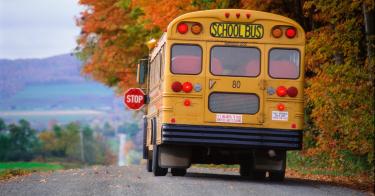At last, it’s fall. Kids are going back to school, waiting for morning school buses at street corners.
But what if the bus doesn’t come?
This is what is happening to Tracy and Miranda (not their real names), sisters in 10th and 12th grade who attend Meade Senior High School in Fort Meade, Maryland. The school bus is supposed to pick them up at 7:52 a.m. for their 8:30 a.m. class, but sometimes it shows up late, and sometimes it doesn’t show up at all.
When Bus 275 is late, Tracy and Miranda miss class time. When it doesn’t show up, they miss an entire day of school. Their single mother has to leave at 6:30 am for work, so she cannot drive them. And the school isn’t responding to parents’ complaints.
I called Mark Anthony, Transportation Specialist of the Meade Area, for comment. He referred my call to Bob Mosier in Anne Arundel County’s Communications Department, who has after five days not yet returned my call.
>>> New York Taxis Want to Kick Out Uber and Lyft. They Should Be Targeting Regulations.
Tracy told me, “It’s really exhausting having to miss half of first period every day and then not knowing what to do in class. Especially when my first period class is being taught virtually in the library, so it’s even more difficult to communicate with the teacher.”
Miranda added, “We walk out [of] the house not knowing if the bus is going to show up or not…or if it’s going to come extremely late. It’s tiring having to stand outside for really long. What are we going to do when it rains or when winter comes?”
Here’s a solution for that. HopSkipDrive, founded in 2014, has drivers trained to pick up children and take them to where they need to go. Hired by school systems to complement school bus systems, HopSkipDrive provides a different service than Uber and Lyft. Drivers have received a thorough background check, and they have experience caring for kids at home or at work.
HopSkipDrive drivers want additional, flexible, earnings opportunities where they can drive children for a few hours a week. This is a win-win: drivers have flexible opportunities, and school districts can take advantage of a network of screened drivers who can quickly respond to evolving needs of schools and students.
Since 2014, HopSkipDrive drivers have driven more than 20 million miles with no critical safety incidents, carrying over 2 million children. The company has served more than 16,000 schools in 12 states. But Maryland’s bus-centric regulations make it prohibitive for HopSkipDrive to operate.
Anne Arundel County has allocated $69 million for transportation in its budget for the 2022-2023 academic (fiscal) year, of which $60 million will be spent on contracting out for bus services. But this isn’t working for Tracy and Miranda and many others. With many school buses less than 50 percent full and a shortage of drivers, hiring a service to pick some students up is less expensive than another bus. School systems hire HopSkipDrive because the service can be cheaper than a school bus.
The popular perception is that most children take buses, with few seats available. In reality, according to the National Household Travel Survey from the U.S. Department of Transportation, 33 percent of school children took the bus to school, 54 percent were driven, and 10 percent walked or biked. (These data are from 2017, but the latest data, from 2020, are not representative due to the pandemic.)
According to a 2022 RAND Corporation report by Heather Schwartz and Melissa Kay Diliberti, 74 percent of school districts reported shortages of bus drivers, with 57 percent reporting a severe shortage. After substitute teachers, the greatest shortages were for bus drivers, because in today’s tight job market, with over 11 million job openings, bus drivers can find better-paying jobs.
Why won’t Maryland hire a company such as HopSkipDrive to get Tracy and Miranda and others like them to school? A report by Prismatic Services on transportation for students in Anne Arundel County concludes that “Maryland currently has overly restrictive rules that do not result in significantly greater student safety but do reduce service quality while likely increasing costs.”
>>> The Pandemic Changed How We Work. It’s Time for Labor Laws to Change, Too.
Maryland’s new rules for “alternative vehicles,” put in place in 2021, include requiring every vehicle to have an audible backup warning alarm installed; fire extinguishers, bodily fluid clean-up kits, and seatbelt cutters in cars; inspections twice per year by the local school; and five hours of training per driver.
HopSkipDrive takes children to school using local experienced caregivers driving their own vehicles, which have been inspected and approved by qualified mechanics. The Maryland safety goals can be achieved through different means that won’t be a barrier to getting qualified drivers on the road, Trish Donahue, Vice President at HopSkipDrive, told me. A backup warning alarm makes sense on a school bus where visibility is an issue, but not on a Toyota Prius that has a backup camera.
HopSkipDrive ensures drivers are safe by requiring driving experience, a clean motor vehicle history, and conducting virtual training on safe driving. The company has telematics that detect unsafe driving behavior during each and every ride. Lastly, semi-annual vehicle inspections don’t need to be done by the local school, but by qualified mechanics.
Maryland has the best of intentions with its safety regulations, but these regulations are resulting in fewer drivers for the school system. Students such as Tracy and Miranda are falling behind by not getting the education they need. It’s time to move to a more flexible model that doesn’t compromise safety and allows adding a network of smaller vehicles to take children to school.
This piece originally appeared in Forbes https://www.forbes.com/sites/dianafurchtgott-roth/2022/09/23/maryland-regulations-prevent-kids-from-getting-to-school/?sh=3bbc6d5d737d




